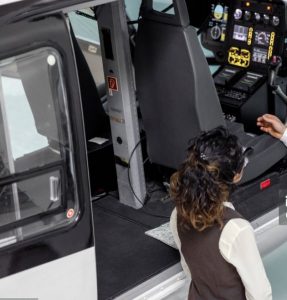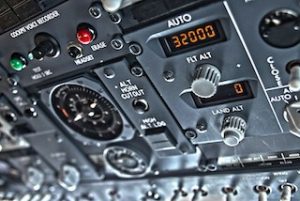Benefits Of Open AI To Airline Pilots
 Artificial intelligence has made significant strides in various industries, and the aviation sector is no exception. The integration of AI into flight operations, particularly for airline pilots, has the potential to drastically enhance pilot performance, safety, and efficiency. Among the various forms of AI, open AI, which refers to AI systems, algorithms, and tools that are accessible to the public, has become an increasingly valuable tool for the aviation industry. Open AI offers pilots, training organizations, and airlines a flexible and cost-effective solution to improve flight operations and pilot training.
Artificial intelligence has made significant strides in various industries, and the aviation sector is no exception. The integration of AI into flight operations, particularly for airline pilots, has the potential to drastically enhance pilot performance, safety, and efficiency. Among the various forms of AI, open AI, which refers to AI systems, algorithms, and tools that are accessible to the public, has become an increasingly valuable tool for the aviation industry. Open AI offers pilots, training organizations, and airlines a flexible and cost-effective solution to improve flight operations and pilot training.
This article explores the benefits of open AI to airline pilots, detailing how it enhances safety, reduces operational costs, improves training, and streamlines decision-making processes, among other advantages. Additionally, we will discuss how open AI can lead to a safer, more efficient, and environmentally sustainable aviation industry.
Open AI
Before diving into the specific benefits for airline pilots, it is important to understand what open AI is and how it differs from proprietary AI systems. Open AI refers to AI technologies and models that are publicly available for use, modification, and distribution. Open AI frameworks, such as TensorFlow, PyTorch, and OpenAI GPT, enable developers and researchers to access and build upon pre-existing AI technologies, contributing to a more collaborative and transparent AI ecosystem.
For the aviation industry, open AI presents an opportunity to customise AI tools and integrate them into various aspects of flight operations, from flight training to real-time assistance during flight. By utilising open AI, airlines can implement cost-effective solutions that benefit both pilots and the broader aviation ecosystem.
Benefits of Open AI to Airline Pilots
1) Enhanced pilot training and education
The primary benefit of open AI in aviation is its ability to revolutionize pilot training. Traditionally, pilots have undergone rigorous training programs that involve a combination of theoretical classroom instruction and practical flight hours. While these training methods are effective, they can be time-consuming, expensive, and often fail to provide personalized learning experiences for individual pilots.
Open AI can dramatically improve pilot training by offering intelligent tutoring systems that tailor the learning experience to each pilot’s unique needs and progress. Using data from various sources, such as flight simulators, real-time flight data, and performance metrics, AI can create a customised training program. For instance, if a pilot struggles with a particular maneuver or flight scenario, the AI system can generate additional training exercises focused on that specific area, ensuring the pilot receives the targeted practice they need to improve.
Furthermore, AI-driven flight simulators can be integrated into pilot training programs, offering more realistic and adaptive training environments. Unlike traditional simulators that follow a pre-programmed script, AI-powered simulators can respond dynamically to the pilot’s actions, adjusting the level of difficulty and presenting new challenges based on the pilot’s performance. This results in a more engaging and effective learning experience, allowing pilots to prepare for a wider range of real-world scenarios.
2) Improved decision-making and real-time assistance
Open AI has the potential to enhance decision-making during flights, particularly in critical or high-pressure situations. Airline pilots are often faced with complex, time-sensitive decisions, especially in emergency scenarios such as sudden changes in weather conditions, mechanical failures, or unexpected system malfunctions. In such cases, AI-driven systems can assist pilots by providing real-time recommendations based on data from sensors, weather reports, and flight systems.
For example, AI can analyze data from the aircraft’s avionics and external sensors to identify potential risks or abnormalities. If the system detects an issue, such as an engine malfunction or severe turbulence ahead, it can notify the pilot and suggest potential corrective actions, such as adjusting altitude, speed, or route. This real-time decision support helps pilots make faster, more informed choices, thereby reducing the likelihood of human error and enhancing safety.
Additionally, AI-powered systems can assist pilots with routine tasks such as flight path optimisation. By analyzing weather patterns, air traffic, and fuel consumption in real time, AI can suggest the most efficient route for the flight, saving fuel and reducing costs. AI can even adjust the flight plan mid-flight, based on new information such as weather changes, ensuring optimal flight conditions throughout the journey.
3) Enhanced situational awareness
Situational awareness is one of the most important skills a pilot must possess. Pilots need to constantly monitor a variety of factors, including weather conditions, air traffic, flight systems, and the behavior of the aircraft, to make informed decisions. Maintaining situational awareness during long flights, especially in challenging conditions or at night, can be difficult and mentally taxing.
Open AI can enhance situational awareness by providing pilots with advanced data visualisation and alert systems. AI systems can process large amounts of data from various sources and present this information in an easy-to-understand format. For example, AI could generate a dynamic flight map that highlights potential hazards, such as thunderstorms, turbulence, or other aircraft in the vicinity, allowing pilots to quickly assess their environment and make proactive adjustments to their flight plan.
Moreover, AI can continuously monitor the pilot’s actions, such as where their eyes are focused and whether they are scanning critical flight instruments, and provide alert prompts if the pilot’s attention drifts from important tasks. This ensures that pilots are always aware of potential risks, even in high-stress or fatigue-inducing situations.
4) Proactive maintenance and predictive analytics
In addition to assisting pilots during flight, open AI can also improve the maintenance and operational efficiency of aircraft. AI-driven systems can analyze data from aircraft sensors and flight logs to identify patterns that may indicate potential mechanical issues or performance degradation. This allows airlines to take a proactive approach to maintenance, addressing issues before they become critical and minimising the risk of in-flight malfunctions.
By leveraging predictive analytics, AI can forecast when components are likely to need maintenance or replacement, optimising the scheduling of repairs and reducing downtime for aircraft. This is particularly beneficial in the context of fleet management, as airlines can ensure that their planes are always in top condition without unnecessary delays or costly emergency repairs. For pilots, this means fewer technical issues during flights and greater confidence in the reliability of the aircraft they are operating.
5) Reduced cognitive load and fatigue
Piloting an aircraft is a highly demanding job that requires constant attention, decision-making, and multitasking. Long-haul flights, in particular, can lead to pilot fatigue, which has been linked to a higher risk of errors and accidents. Open AI can help reduce cognitive load and alleviate some of the mental strain on pilots by automating routine tasks and providing timely assistance when needed.
For instance, AI can take over tasks like flight monitoring, checking navigation systems, and tracking air traffic, allowing pilots to focus more on high-level decision-making and situational awareness. Additionally, AI can help manage crew communications by automatically transcribing and summarising radio transmissions, freeing pilots from having to manually interpret or relay information. This allows pilots to concentrate on the most important aspects of their job without becoming overwhelmed by secondary tasks.
Moreover, AI can monitor a pilot’s physiological data, such as heart rate and sleep patterns, and provide suggestions for managing fatigue. By helping pilots maintain their mental and physical well-being, AI can play a key role in ensuring that pilots remain alert and focused throughout their shift, improving safety and performance.
6) Improved flight safety and incident prevention
Safety is the top priority in aviation, and AI can play a significant role in reducing the risk of accidents and improving overall flight safety. By integrating AI into various aspects of flight operations, airlines can enhance safety protocols, minimize human error, and predict potential hazards before they arise.
Open AI can improve safety by providing pilots with automated hazard detection systems that analyse real-time data from the aircraft, weather reports, and air traffic control. For example, AI can identify in-flight anomalies such as rapid altitude changes, unusual sensor readings, or deviations from the flight path, and alert the pilot to take corrective action. Similarly, AI can assist in detecting potential collisions with other aircraft by analysing air traffic data and predicting potential conflicts.
Additionally, AI-powered systems can assist in flight data monitoring, continuously tracking parameters like speed, altitude, and engine performance to detect early signs of system failure. By catching these issues early, AI can help pilots take timely action to prevent incidents or accidents, significantly improving flight safety.
7) Environmental sustainability and efficiency
The aviation industry is under increasing pressure to reduce its environmental impact, particularly in terms of fuel consumption and carbon emissions. Open AI can play a role in making airline operations more environmentally sustainable by helping pilots optimise flight routes and fuel usage.
AI-powered systems can analyse real-time weather conditions, wind patterns, and air traffic to suggest the most fuel-efficient flight paths. By continuously adjusting the flight plan to minimize fuel consumption and optimize engine performance, AI can help reduce the carbon footprint of individual flights. In the long term, this could lead to a substantial reduction in the aviation industry’s overall emissions, contributing to global sustainability goals.
Moreover, AI can assist pilots in managing energy-efficient flying techniques, such as reducing unnecessary speed or altitude changes, further contributing to fuel savings and lowering environmental impact.
Challenges and limitations of open AI for airline pilots
While open AI offers numerous benefits to airline pilots, there are also challenges and limitations to consider. These include:
- Data security and privacy: The use of open AI in flight operations requires access to vast amounts of data, some of which may be sensitive. Ensuring the security of this data is crucial to avoid potential breaches or misuse.
- Reliance on technology: While AI can enhance decision-making, there is a risk that pilots may become overly reliant on AI systems, potentially weakening their own decision-making and problem-solving abilities.
- Integration with existing systems: Implementing AI in the complex systems of modern aircraft and airlines can be challenging. AI must be seamlessly integrated with existing avionics and flight control systems to avoid compatibility issues.
- Regulatory challenges: The aviation industry is heavily regulated, and the introduction of AI systems into flight operations will require compliance with stringent safety and regulatory standards. Ensuring that AI systems meet these requirements will take time and careful oversight.
Conclusion
Open AI has the potential to revolutionize the aviation industry by offering airline pilots enhanced training, decision-making support, improved situational awareness, and increased flight safety. By leveraging open AI technologies, airlines can reduce operational costs, improve pilot performance, and contribute to environmental sustainability efforts. While there are challenges to overcome, the benefits of open AI for airline pilots are clear, a safer, more efficient, and sustainable aviation future. As the technology continues to evolve, it is likely that AI will play an even greater role in shaping the way pilots are trained, how they operate flights, and how the aviation industry as a whole functions.










